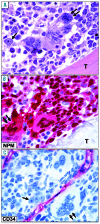Molecular and alternative methods for diagnosis of acute myeloid leukemia with mutated NPM1: flexibility may help
- PMID: 20378574
- PMCID: PMC2857180
- DOI: 10.3324/haematol.2009.017822
Molecular and alternative methods for diagnosis of acute myeloid leukemia with mutated NPM1: flexibility may help
Figures


Comment on
-
Can cytoplasmic nucleophosmin be detected by immunocytochemical staining of cell smears in acute myeloid leukemia?Haematologica. 2010 Apr;95(4):670-3. doi: 10.3324/haematol.2009.011817. Epub 2009 Dec 16. Haematologica. 2010. PMID: 20015883 Free PMC article.
Similar articles
-
Acute myeloid leukemia with mutated NPM1 demonstrating multilineage dysplasia and marked thrombocytosis.Br J Haematol. 2017 Aug;178(3):350. doi: 10.1111/bjh.14741. Epub 2017 Jul 5. Br J Haematol. 2017. PMID: 28677819 No abstract available.
-
Acute myeloid leukemia with NPM1 and FLT3 ITD mimicking acute promyelocytic leukemia.Blood. 2020 Sep 17;136(12):1467. doi: 10.1182/blood.2020007198. Blood. 2020. PMID: 32941638 No abstract available.
-
Acute myeloid leukemia with mutated nucleophosmin (NPM1): is it a distinct entity?Blood. 2011 Jan 27;117(4):1109-20. doi: 10.1182/blood-2010-08-299990. Epub 2010 Oct 28. Blood. 2011. PMID: 21030560 Review.
-
Development of a flow cytometric method to detect the presence of mutated nucleophosmin 1 in acute myeloid leukemia.Hematol Oncol Stem Cell Ther. 2015 Sep;8(3):106-14. doi: 10.1016/j.hemonc.2015.06.009. Epub 2015 Jul 9. Hematol Oncol Stem Cell Ther. 2015. PMID: 26183674
-
Minimal/Measurable Residual Disease Monitoring in NPM1-Mutated Acute Myeloid Leukemia: A Clinical Viewpoint and Perspectives.Int J Mol Sci. 2018 Nov 6;19(11):3492. doi: 10.3390/ijms19113492. Int J Mol Sci. 2018. PMID: 30404199 Free PMC article. Review.
Cited by
-
NPM1 Mutation Analysis in Acute Myeloid Leukemia: Comparison of Three Techniques - Sanger Sequencing, Pyrosequencing, and Real-Time Polymerase Chain Reaction.Turk J Haematol. 2018 Mar 1;35(1):49-53. doi: 10.4274/tjh.2017.0095. Epub 2017 Nov 13. Turk J Haematol. 2018. PMID: 29129825 Free PMC article.
-
A single center analysis of nucleophosmin in acute myeloid leukemia: value of combining immunohistochemistry with molecular mutation analysis.Haematologica. 2013 Oct;98(10):1532-8. doi: 10.3324/haematol.2012.079806. Epub 2013 May 28. Haematologica. 2013. PMID: 23716555 Free PMC article.
-
A Curious Novel Combination of Nucleophosmin (NPM1) Gene Mutations Leading to Aberrant Cytoplasmic Dislocation of NPM1 in Acute Myeloid Leukemia (AML).Genes (Basel). 2021 Sep 16;12(9):1426. doi: 10.3390/genes12091426. Genes (Basel). 2021. PMID: 34573408 Free PMC article.
-
Nucleophosmin1 (NPM1) abnormality in hematologic malignancies, and therapeutic targeting of mutant NPM1 in acute myeloid leukemia.Ther Adv Hematol. 2020 Feb 3;11:2040620719899818. doi: 10.1177/2040620719899818. eCollection 2020. Ther Adv Hematol. 2020. PMID: 32071709 Free PMC article. Review.
-
Development of E-ice-COLD-PCR assay combined with HRM analysis for Nucleophosmin1 gene mutation detection in acute myelogenous leukemia.PLoS One. 2022 Sep 14;17(9):e0274034. doi: 10.1371/journal.pone.0274034. eCollection 2022. PLoS One. 2022. PMID: 36103476 Free PMC article.
References
-
- Lowenberg B. Acute myeloid leukemia: the challenge of capturing disease variety. Hematology Am Soc Hematol Educ Program. 2008:1–11. - PubMed
-
- Falini B, Mecucci C, Tiacci E, Alcalay M, Rosati R, Pasqualucci L, et al. Cytoplasmic nucleophosmin in acute myelogenous leukemia with a normal karyotype. N Engl J Med. 2005;352(3):254–66. - PubMed
-
- Alcalay M, Tiacci E, Bergomas R, Bigerna B, Venturini E, Minardi SP, et al. Acute myeloid leukemia bearing cytoplasmic nucleophosmin (NPMc+ AML) shows a distinct gene expression profile characterized by up-regulation of genes involved in stem-cell maintenance. Blood. 2005;106(3):899–902. - PubMed
-
- Falini B, Nicoletti I, Martelli MF, Mecucci C. Acute myeloid leukemia carrying cytoplasmic/mutated nucleophosmin (NPMc+ AML): biologic and clinical features. Blood. 2007;109(3):874–85. - PubMed
Publication types
MeSH terms
Substances
LinkOut - more resources
Full Text Sources
Medical

